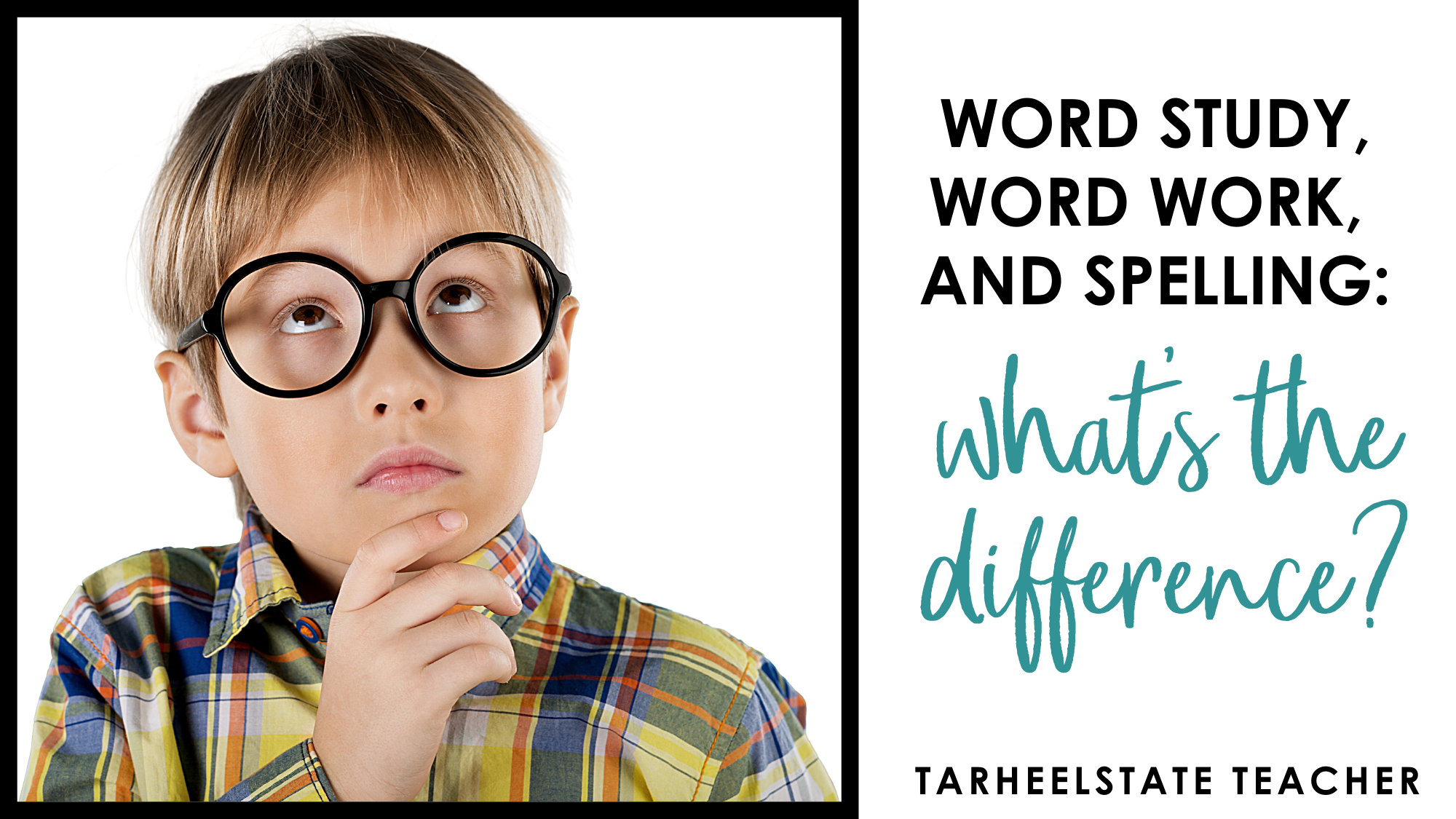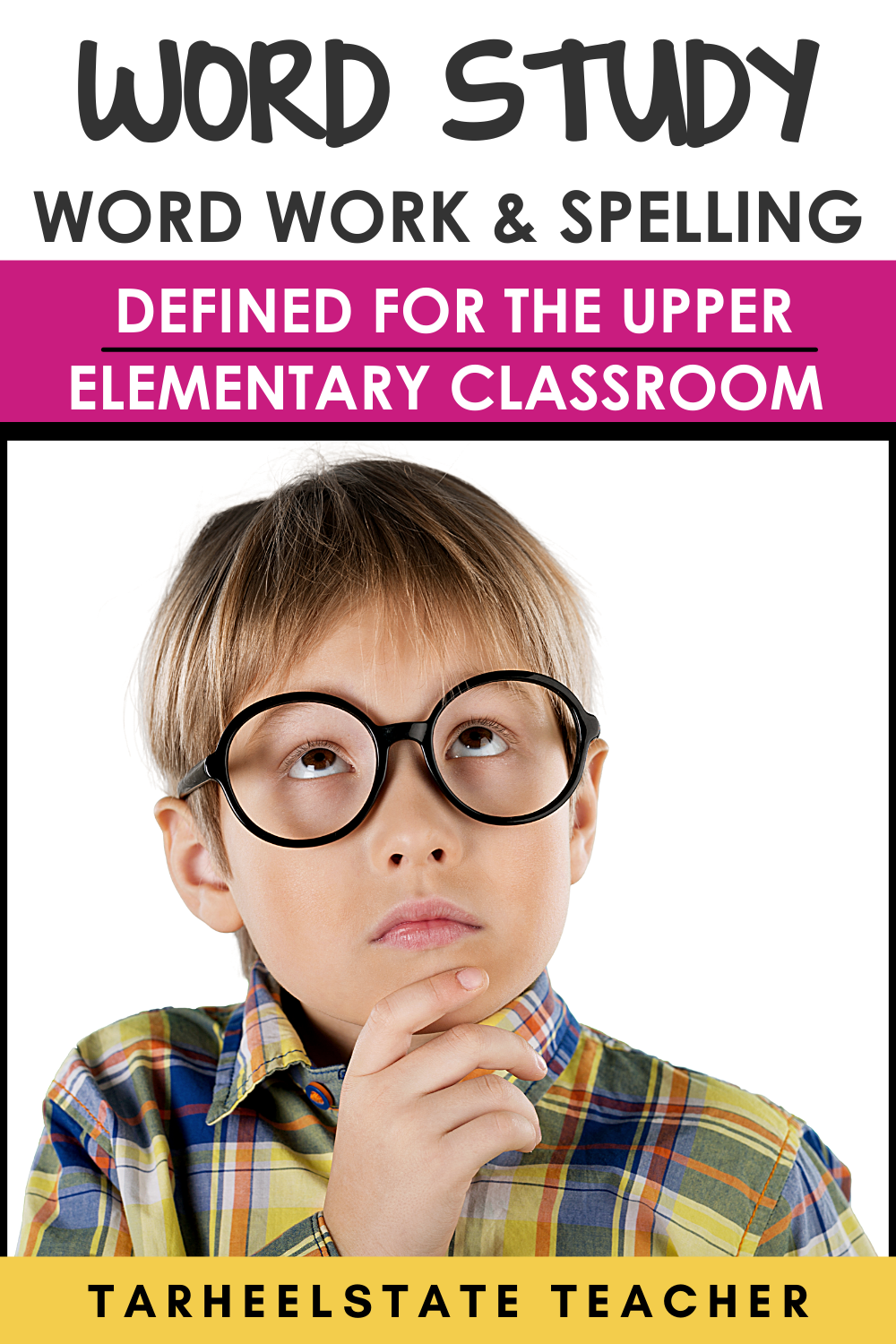Word Study, Word Work, and Spelling: What’s the difference?
Word study, word work, and spelling...confused about the difference and why it matters in your upper elementary classroom?! These three types of word learning structures often get thrown around interchangeably in the upper elementary teaching world, but they have important differences in approach and purpose. You may have landed on this blog post as a new teacher who really wants to know what distinguishes each practice, as a veteran teacher who’s curious to see if our definitions match, or as someone who falls in between. While word study, word work, and spelling have quite a bit of crossover, there are also some fundamental differences that we should take into consideration.
I was always an A+ speller, but I had everything going for me in that department—I loved to read, my ability to memorize was fantastic, my enjoyment of all things school and my type-A personality allowed me to thrive on practice worksheets, I loved having my mom call words out to me to spell, and I gave myself my own spelling tests to make sure I would do well on the tests...heck, I probably even had index cards to help myself focus on any words with tricky spellings. How many of your students sound like that kind of kid?!
In recent years there has been a shift away from traditional spelling programs where students focus solely on memorizing a list of (possibly) random words in order to perform well on a spelling test. Teachers and parents alike often complain that students are able to perform well on spelling tests but continue to misspell words in their written work. It’s like cramming for a test and then forgetting much of the information once time has passed.
Before we get into my recommendations for an upper elementary word study/spelling program that works, let’s make sure we have a good understanding of the nuances of spelling, word study, and word work.
WHAT IS SPELLING?
Traditional spelling instruction focuses on learning to spell words correctly given a list of words. In upper elementary, how words end up on a students' spelling list can run the gamut. The word list can be based on a spelling pattern, personalized based on a sight-word assessment, derived from books students are reading, come from content area vocabulary, or a combination of sources. Language Arts textbooks and literacy curriculums often include lists of spelling words and lessons for students to complete but they are often not based on developmental spelling levels or individual students’ needs.
In hopes of differentiating spelling lists, teachers sometimes have students choose half of their words from a class word list and half of their words from a “personal” list of words that students need to master.
While a spelling program can teach phonics and word pattern concepts, the focus is often on memorization, spelling tests, and moving on to new words the following week. Spelling activities often involve repeated activities and practice writing words so that students can spell them correctly when they are tested on them—think “three times each,” rainbow words, word pyramids, ABC order, and more as ways to make it fun for students to write their spelling words again and again.
WHAT IS WORD STUDY?
In word study programs, students are guided to discover and make generalizations about patterns in words and how words work. Word study aims to improve students’ ability to read words, spell words accurately, and understand the meaning of words, including how adding different word parts modify word meanings. “Studying” words is a foundational aspect of word study and moves away from a strict focus on memorizing how words are spelled.
For example, students participating in a word study block may be learning about words that end in -ck and -ke. Through reading, sorting, searching for, and writing words that fit in this particular category, students are guided to discover that most words ending in -ke make the long vowel sound, while most words ending in -ck make a short vowel sound. In word study, students move from noticing similarities and differences in word patterns, sounds, and spellings to being able to verbalize a common rule or way words with those patterns and sounds function.
While spelling words accurately is a goal of word study, so is applying the knowledge of word patterns to spell other words that also follow the spelling pattern; transferring their learning to spell new words is a key goal of word study.
Differentiation is another cornerstone of a true word study program. In classrooms where word study is implemented, students are assessed with a spelling inventory to see where they are in their understanding of phonics and word patterns. The inventory contains a variety of words and increases in complexity to identify students’ mastery of sound patterns and ability to represent the sounds they hear through spelling.
Based on the assessment, students are grouped by their developmental level. For example, students who don’t show a solid understanding of long vowel patterns would not be studying how prefixes and suffixes impact a word’s meaning in the scope of word study (although, the teacher may implement whole group lessons focused on Greek and Latin roots and students will surely encounter those kinds of words in content areas like science and social studies.)
Word study often involves tactile sorting of words on word cards where students group words based on spelling patterns and sounds. Students then document their word sorts by copying it down on paper. This practice helps students think about and come up with ideas about how the words work.
WHAT IS WORD WORK?
Word work is largely used with pre-readers and early readers in preschool and lower elementary grades with a focus on phonics, sight words, and spelling—all critical for our earliest readers! It consists of a variety of teacher modeling, hands-on activities, and games that encourage word building and word reading. In my experience, word work has usually been a component added into students’ guided reading time. Many lower grades teachers try to add a few minutes of word work at the start or end of most of their guided reading lessons.
Word work should bring to mind images of students building words and writing different words repeatedly. During word work, students may learn about word families like -at and -an. They can practice reading and writing new words by changing the beginning consonant (pat/mat/cat and fan/man/pan). Word work is also a time to help students memorize high frequency words that are key for developing as readers. Playing with words and manipulating parts of words is a key component of word work.
WHAT’S AN UPPER ELEMENTARY TEACHER TO DO?
I have found that a well balanced word-learning program has the best aspects of word study, word work, and spelling AND as the teacher, you should be well aware of your goals for whichever program you choose to implement.
I can't not say this--word study/spelling time needs to be differentiated based on students' developmental levels. If not, in my experience spelling time just feels like a punishment to some students and a waste of time for others. The days of having all students in a class or grade level working to master and spell the same word list should be a thing of the past for upper elementary classrooms. And, when your students’ assignments are based on their developmental level, they’ll be more eager to participate and have a growth mindset about their spelling and word attack abilities.
Next, we can use elements of word work to bring fun and engagement to our word study program. Games and activities can give students many opportunities to see and work with words and word patterns. These word-work-like experiences will naturally support our upper elementary students in making generalizations about spelling patterns, word pronunciations, and word meanings.
My ultimate recommendation for upper elementary teachers is to create an inquiry-based word study routine where the foundational goal is for students to learn to generalize the consistencies they notice in words in ways that help them become better readers and writers. This routine should incorporate 1-2 days of playing with words and sounds and 1-2 low-stress days that are focused on spelling words accurately. #teachersonamission!
Because I’ve realized that the hands-on FUN was missing from my word study routine, I’ve spent 2021 running down the long path of creating word study games and activities for all levels of word study. These games and centers are aligned to Words Their Way, but can complement any word study program where the focus is on word patterns and sounds. See what these are all about here! With the addition of board games, card games, spinners, and picture board activities, you are sure to find the spark of joy in word study that I’ve felt all these years!
Struggling to picture what this would look like on paper?! Don't worry! I've got you covered in some upcoming posts about word study routines and schedules! Stay tuned! (Or, better yet, grab your FREE Word Study Terminology download and you’ll be updated when I publish new posts about word study!)






